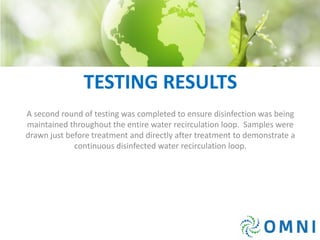Omni Solutions provides water treatment systems that use advanced oxidation processes to purify water. Their CBW system uses counter flow mixing, an advanced oxidative gas generator, and UV irradiation lamps to reduce bacteria and other contaminants by 99.9% without chemicals. The system injects oxidative gas generated on-site and exposes the water to UV light to generate hydroxyl radicals that safely and effectively treat the water.












![HYDROXYL RADICALS
Names
IUPAC nameHydroxyl radical
Systematic IUPAC nameOxidanyl
[1]
(substitutive)
Hydridooxygen(•)
[1]
(additive)
Other namesHydroxy
Hydroxyl
λ
1
-Oxidanyl
Identifiers
CAS Number 3352-57-6
ChEBI CHEBI:29191
ChemSpider 138477
Gmelin Reference 105
Jmol 3D model Interactive image
KEGG C16844
PubChem 157350
InChI[show]
SMILES[show]
Properties
Chemical formula HO
Molar mass 17.01 g·mol
−1
Thermochemistry
Std molar
entropy (S
o
298)
183.71 J K
−1
mol
−1
Std enthalpy of
formation (ΔfH
o
298)
38.99 kJ mol
−1
Except where otherwise noted, data are given for materials in their standard state (at 25 °C
[77 °F], 100 kPa).
Infobox references](https://image.slidesharecdn.com/918d293d-a053-4fcd-bf25-8fcddbea3492-160912153401/85/OMNI-CBW-Product-Presentation-13-320.jpg)


![OZONE
Names
IUPAC nameTrioxygen
Identifiers
CAS Number 10028-15-6
ChEBI CHEBI:25812
ChemSpider 23208
EC Number 233–069–2
Gmelin Reference 1101
IUPHAR/BPS 6297
Jmol 3D model Interactive image
Interactive image
MeSH Ozone
PubChem 24823
RTECS number RS8225000
UNII 66H7ZZK23N
InChI[show]
SMILES[show]
Properties
Chemical formula O3
Molar mass 48.00 g·mol
−1
Appearance colorless to pale blue gas
[1]
Odor pungent
[1]
Density 2.144 mg cm
−3
(at 0 °C)
Melting point −192.2 °C; −313.9 °F; 81.0 K
Boiling point −112 °C; −170 °F; 161 K
Solubility in water 1.05 g L
−1
(at 0 °C)
Solubility very soluble in CCl4, sulfuric acid
Vapor pressure >1 atm (20 °C)
[1]
Refractive index(nD) 1.2226 (liquid), 1.00052 (gas, STP,
546 nm — note high dispersion)
[2]
Structure
Space group C2v
Coordination geometry Digonal
Molecular shape Dihedral
Hybridisation sp
2
for O1
Dipole moment 0.53 D](https://image.slidesharecdn.com/918d293d-a053-4fcd-bf25-8fcddbea3492-160912153401/85/OMNI-CBW-Product-Presentation-16-320.jpg)





![HYDROGEN PEROXIDE
Names
IUPAC namehydrogen peroxide
Other namesDioxidane
Oxidanyl
Identifiers
CAS Number 7722-84-1
ChEBI CHEBI:16240
ChEMBL ChEMBL71595
ChemSpider 763
EC Number 231-765-0
IUPHAR/BPS 2448
Jmol 3D model Interactive image
KEGG D00008
PubChem 784
RTECS number MX0900000 (>90% soln.)
MX0887000 (>30% soln.)
UNII BBX060AN9V
UN number 2015 (>60% soln.)
2014 (20–60% soln.)
2984 (8–20% soln.)
Properties
Chemical formula H2O2
Molar mass 34.0147 g/mol
Appearance Very light blue color; colorless in
solution
Odor slightly sharp
Density 1.11 g/cm
3
(20 °C, 30% (w/w)
solution )
[1]
1.450 g/cm
3
(20 °C, pure)
Melting point −0.43 °C (31.23 °F; 272.72 K)
Boiling point 150.2 °C (302.4 °F; 423.3 K)
(decomposes)
Solubility in water Miscible
Solubility soluble in ether, alcohol
insoluble in petroleum ether
Vapor pressure 5 mmHg (30 °C)
[2]
Acidity (pKa) 11.75
Refractive index(nD) 1.4061
Viscosity 1.245 cP (20 °C)
Dipole moment 2.26 D](https://image.slidesharecdn.com/918d293d-a053-4fcd-bf25-8fcddbea3492-160912153401/85/OMNI-CBW-Product-Presentation-22-320.jpg)









